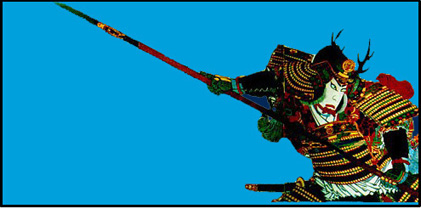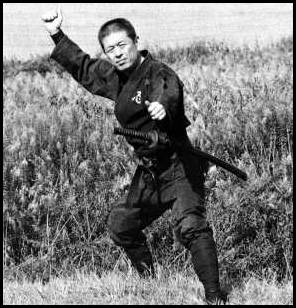|
|
 |
 |
| About Bujinkan |
 |
|
|
|
About the Bujinkan

|
Bujinkan Budo Taijutsu is a traditional
Japanese martial art, teaching unarmed combat and traditional weapons.
This martial art has been commonly taught as Ninjutsu in the West but is actually
an amalgamation of nine different martial arts, of which only three are Ninjutsu
Ryu. The nine schools taught under the banner of the Bujinkan are:
Togakure Ryu Ninpo, Gyokko Ryu Koshijutsu, KukiShinden
Ryu Taijutsu, Koto Ryu Koppojutsu, ShindenFudo Ryu Dakentaijutsu, TagakiYoshin
Ryu Jutaijutsu, Gyokushin Ryu Ninpo, Gikan Ryu Koppojutsu, Kumogakure Ryu
Ninpo,
The training method of the Bujinkan Training Group, Harstad (Norway) involves little
formality and no forced respect. The atmosphere is one of learning, with
practitioners communicating and co-operating with each other while receiving
guidance from the instructor. The teaching method used has a three-fold
purpose of firstly providing a realistic self protection ability; secondly,
ensuring that the ability taught is appropriate to the student's skill
level, and finally, developing an above-average sense of self awareness
and self-control in the practitioner.
Generally, each class attended will involve one or two of the many subjects
that are studied in the Bujinkan Dojo. For example, it might be a class
on blocking and striking, or grappling and throwing or a combination of
both, or the application of weapons in self defense. The pace of each class
is created by one or more of four fundamental training styles, slow, soft,
fast and hard. Each of these different styles offers students an important
learning experience. Beginners are mostly exposed to the slow and soft style.
This provides a level at which one can easily understand and practice natural
body movement, develop co-ordination and balance. With the co-operation
of a willing partner at this stage, one can experience and experiment with
the training aspects of distance, angling, timing and balance-breaking. Senior students
frequently train in the hard and fast manner in order to obtain a uniform
experience and understanding of Bujinkan principles at realistic combat
speed.
The rules and regulations of Bujinkan Rakunin Dojo, Harstad (Norway) are the same as those of
the Honbu Dojo.
BUDO TAIJUTSU
On a physical level, this subject covers the traditional aspects of
the Bujinkan combat method which includes:
-
JUNAN TAISO: Body flexibility
-
DAKEN TAIJUTSU: Strikes, kicks and blocks
-
JUTAIJUTSU: Grappling, throwing and limb control
-
TAIHENJUTSU: Rolls, leaps and evasions
On a mental level, placed in the controlled combat environment of the dojo,
a student can quickly begin to confront emotions and attitudes that are
not usually recognized in everyday living.
These could be, for example: aggression, ego, shyness, or fear of confronting
personal limitations or even fear of failure itself. As students express
any of these non-productive aspects of their personality, they are encouraged
and guided to acknowledge and overcome them, thereby enabling a greater level of success to be achieved in any and every area of their
personal lives. Through the process of this training method, students develop
into mature martial artists, respected for their physical attributes and
balanced character.
BUKI
Beginners are introduced to the application of traditional weapons
in self-defense when they have demonstrated the appropriate level of self
control and co-ordination. Many traditional weapons are studied (within
the limits of Irish law) including:
-
Bojutsu - long, medium and short stick and staff techniques
-
Kenjutsu - Sword techniques
-
Tantojutsu - Knife techniques
-
Kusarijutsu - Short chain techniques
-
Juttejutsu - arresting techniques
-
Naginatajutsu - Halbard techniques
-
Sojutsu - Spear techniques
All bladed weapons used in training such as swords, knives etc,
are of the safety variety, i.e. blunt. On some occasions these weapons
are replaced with mock wooden replicas.
Students are also taught to understand the principles of self-defense that
together forms the very essence of weapon use. This enables Bujinkan practitioners
to instantly adapt any object of any description as an aid in self-protection.
GRADINGS
Bujinkan Budo Taijutsu uses the
traditional Japanese belt system with ten kyu grades (10th
is white belt, with the following 9 being green or red belts depending on
gender and preferance), from beginner to Shodan (1st Dan black belt), denoted by stars
above the school crest. There are also fifteen black-belt Dan grades. Unlike in most Japanese martial arts, a black belt does not mean that a student is
authorized to open a dojo and to become an instructor. Only people of fifth
Dan level, or Shidoshi, and above may open a full dojo. (The title of Shidoshi-ho
is given to instructors-in-training)

Soke Masaaki Hatsumi
The function of each branch of the Bujinkan Dojo is to disseminate and
teach the accumulated knowledge of
Dr Masaaki Hatsumi's
Divine Warrior School. This is achieved in Norway through regular training
sessions and seminars, where Shidoshi, or instructors,
of international standing hold courses.
|
|
|
|
 |
|



